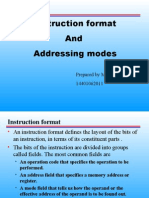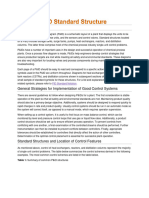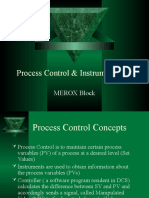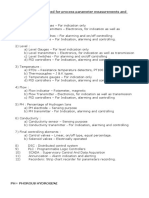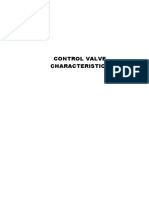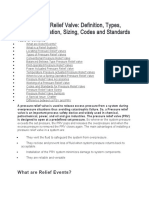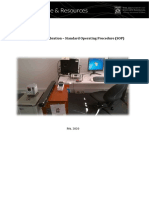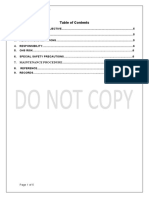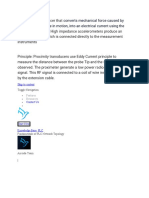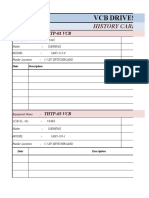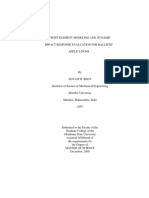0 ratings0% found this document useful (0 votes)
13 viewsCompressor Shutdown
Compressor Shutdown
Uploaded by
sanjay sharmaThis document discusses the duties of an instrumentation engineer during a compressor shutdown. It describes various instruments used in a centrifugal compressor like control valves, flow meters, transmitters, switches, and a PLC controller. It then provides details on maintenance and calibration tasks to perform for each instrument during the shutdown, including stroke checking valves, calibrating transmitters, checking switches and probes, and ensuring the PLC system is functioning properly.
Copyright:
© All Rights Reserved
Available Formats
Download as DOCX, PDF, TXT or read online from Scribd
Compressor Shutdown
Compressor Shutdown
Uploaded by
sanjay sharma0 ratings0% found this document useful (0 votes)
13 views6 pagesThis document discusses the duties of an instrumentation engineer during a compressor shutdown. It describes various instruments used in a centrifugal compressor like control valves, flow meters, transmitters, switches, and a PLC controller. It then provides details on maintenance and calibration tasks to perform for each instrument during the shutdown, including stroke checking valves, calibrating transmitters, checking switches and probes, and ensuring the PLC system is functioning properly.
Original Description:
Original Title
compressor shutdown
Copyright
© © All Rights Reserved
Available Formats
DOCX, PDF, TXT or read online from Scribd
Share this document
Did you find this document useful?
Is this content inappropriate?
This document discusses the duties of an instrumentation engineer during a compressor shutdown. It describes various instruments used in a centrifugal compressor like control valves, flow meters, transmitters, switches, and a PLC controller. It then provides details on maintenance and calibration tasks to perform for each instrument during the shutdown, including stroke checking valves, calibrating transmitters, checking switches and probes, and ensuring the PLC system is functioning properly.
Copyright:
© All Rights Reserved
Available Formats
Download as DOCX, PDF, TXT or read online from Scribd
Download as docx, pdf, or txt
0 ratings0% found this document useful (0 votes)
13 views6 pagesCompressor Shutdown
Compressor Shutdown
Uploaded by
sanjay sharmaThis document discusses the duties of an instrumentation engineer during a compressor shutdown. It describes various instruments used in a centrifugal compressor like control valves, flow meters, transmitters, switches, and a PLC controller. It then provides details on maintenance and calibration tasks to perform for each instrument during the shutdown, including stroke checking valves, calibrating transmitters, checking switches and probes, and ensuring the PLC system is functioning properly.
Copyright:
© All Rights Reserved
Available Formats
Download as DOCX, PDF, TXT or read online from Scribd
Download as docx, pdf, or txt
You are on page 1of 6
In this article, we will learn the instrumentation engineer duties during a
compressor shutdown job of a plant.
Before proceeding further, let us see all the instruments used for the safety of
the centrifugal compressor or the controlling/operation of the centrifugal-type
compressor.
Compressor Shutdown Job
The following instruments are installed in a centrifugal compressor:
1. Control valves and their accessories
2. Differential Pressure type flow meters
3. Pressure transmitters
4. Temperature transmitters and RTD/thermocouple
5. Level Transmitter
6. Vibration probes
7. Pressure gauges
8. Temperature gauges
9. Pressure switches
10. Flow switches
11. Level switches
12. Controller: PLC and its cards
Now let us discuss what jobs can be done during the shutdown on all the
above-mentioned instruments
Control Valves and their Accessories
Two types of control valves are used in a centrifugal air compressor. One is
Inlet Guide Vane (IGV) and the other is a Blow-Off Valve or Anti-Surge Valve.
So, we should do the stroke checking of both control valves. If any issue is
found in the control valve during the stroke-checking activity, then we can go
for calibration of the control valves.
Here one important thing to note is that the Blow-Off Valve or Anti-Surge
Valve is an equal percentage type of valve characteristics in many
compressors.
So, refer to any standard document before doing the job on Blow-Off Valve or
Anti-Surge Valve. Check the physical condition of the Air Filter Regulator.
Replace if necessary.
Replace the pressure gauges if needed. If any Solenoid Valve is present on
the control valve, check the solenoid valve as per the standard procedure.
If any other valve accessory is present, then check the same. If a volume tank
is present, then check the PSV of the volume tank.
The calibration of the PSV is very important. Make sure that the PSV is
calibrated.
Differential Pressure type Flow Meters
Differential pressure type flow meters are installed in the compressor to
measure the flow of the gas as well as one of the most important parameters
i.e. flow of the cooling water. Hence, during every opportunity, the differential
pressure type flow meters should be calibrated.
Also, whenever cooling water is isolated and again normalized there will be air
trapped in the DP-type flow meter’s tubing. Hence, after normalization of the
cooling water circuit, the DP-type flow meter of the cooling water should be
flushed.
The flow of the gas is also used for calculating the Surge value. This Surge
value is used in Surge Control System for the protection of the compressor.
Inspect the orifice plate if any opportunity is available.
Pressure Transmitters
Pressure transmitters are used to know the pressure of suction, individual
stage pressure as well as discharge pressure.
The values of the pressure are also used for calculating the surge value.
Check the response of the pressure transmitters and do calibration if needed.
Temperature Transmitters and RTD/Thermocouple Sensors
Temperature transmitters are installed for suction gas, intercooler inlet,
intercooler outlet, and discharge gas temperature measurement. The values
of suction gas temperature and/or discharge gas temperature are taken for
calculation of the Surge value.
The response of the RTD/thermocouple as well as the temperature transmitter
should be checked. One important thing to note here is to carry out the
inspection as well as the hydro test of the thermowell used for the
RTD/thermocouple.
In most cases, thermowells are neglected.
Level Transmitter
Level transmitters are used for measuring the level of lube oil in the lube oil
reservoir.
Generally, differential pressure level transmitters are used for the lube oil
reservoir level measurement. Calibration of the level transmitter should be
done after proper isolation of the lube oil system.
Vibration Probes
Characteristic checking, resistance checking, and response checking of
the vibration monitoring system should be done in every shutdown.
Pressure Gauges
Pressure gauges are used for viewing the pressure of the lines on which they
are installed.
Calibration of the pressure gauges is necessary because, during emergency
conditions like a blackout, pressure gauges can be used to know the pressure
in the system or the line on which they are installed.
Temperature Gauges
Temperature gauges also function like pressure gauges. Hence calibration of
the temperature gauge is also necessary.
Pressure Switches
Pressure switches are installed in seal gas pressure or some other important
pressure parameter on which the compressor should immediately trip.
Ensure that the contact used for the pressure switch remains closed when the
pressure is healthy.
Flow Switches
Flow switches are installed in the cooling water flow line. Cooling water is one
of the most important factors while the compressor is running. Because during
the compression of the gas, the temperature of the gas increases.
Due to increased temperature, the volume of the gas also increases, and
hence more energy is needed to compress the gas.
Hence intercoolers are given which have a cooling water flow to reduce the
temperature of the gas. When the flow is healthy, the contact should be
closed.
Level Switches
Level switches are required to monitor the amount of water in case of an air
compressor in the intercooler.
If there is a high level of condensation in the intercooler then the compressor
should trip. Here also, when the level switch is healthy, the contact should be
closed.
A Controller like PLC and its cards
All connection tightening, panel cleaning jobs, and power supply checking in
the PLC panel should be done during the shutdown of the compressor.
Also, Cause & Effect checking and Interlock checking should be done during
the shutdown of a plant.
You might also like
- Cross Reference Syntetic MWFDocument8 pagesCross Reference Syntetic MWFSuprastowo Bin SarinoNo ratings yet
- KUKA RobotTrainingDocument17 pagesKUKA RobotTrainingOscar Oscar67% (3)
- Advanced Temperature Measurement and Control, Second EditionFrom EverandAdvanced Temperature Measurement and Control, Second EditionNo ratings yet
- SENTEMUL2010 GUI Instruction, Installation, Dumping, EmulationDocument2 pagesSENTEMUL2010 GUI Instruction, Installation, Dumping, Emulationjavier_khanNo ratings yet
- P&IDDocument7 pagesP&IDTagabo AliNo ratings yet
- Chilled Water Balancing For HVAC System Method StatementDocument2 pagesChilled Water Balancing For HVAC System Method Statementamg00771% (7)
- 02B HRSGDocument50 pages02B HRSGrseclen100% (4)
- SMP of BFP: Preventive Mantenance of Boiler Feed Water PumpDocument11 pagesSMP of BFP: Preventive Mantenance of Boiler Feed Water Pumpsanjay sharma100% (2)
- Instruction Format and Addressing ModesDocument30 pagesInstruction Format and Addressing Modesmadhurimapatra1987100% (7)
- All About CompressorsDocument26 pagesAll About CompressorsBulex ExtensiomNo ratings yet
- Principles of Instrumentation & ControlDocument46 pagesPrinciples of Instrumentation & ControlAnjani Ganti100% (2)
- Valves Station ManualDocument125 pagesValves Station Manual윤병택No ratings yet
- Working Principle of Control Valve With DiagramDocument10 pagesWorking Principle of Control Valve With DiagramKhamis AfendiNo ratings yet
- Basic Instrumentation in RefineryDocument15 pagesBasic Instrumentation in RefinerySahil Sahni100% (1)
- Rocess: Process As Used in The Terms Process Control and Process IndustryDocument8 pagesRocess: Process As Used in The Terms Process Control and Process Industryankur neogNo ratings yet
- Air Conditioning Gauges - How Does HVAC Gauges WorksDocument4 pagesAir Conditioning Gauges - How Does HVAC Gauges WorksIsramanNo ratings yet
- Valves Instumentation and ControlDocument43 pagesValves Instumentation and Controlomkar khaladeNo ratings yet
- Manipulator Elements Sergejs BoikoDocument14 pagesManipulator Elements Sergejs BoikoСергей БойкоNo ratings yet
- Separator Operation PDFDocument30 pagesSeparator Operation PDFMadeMaryasaRobed100% (1)
- What Is A Pressure TransmitterDocument3 pagesWhat Is A Pressure TransmitterYun AnitaNo ratings yet
- PID Standard StructureDocument15 pagesPID Standard StructureNghiep TranNo ratings yet
- Chilled Water Balancing For HVAC System Method StatementDocument2 pagesChilled Water Balancing For HVAC System Method StatementGündoğdu Akın0% (1)
- Automatic Operation of BoilerDocument23 pagesAutomatic Operation of BoilerSuhas KassaNo ratings yet
- SOP For Compressor (Instrumentation & Service)Document2 pagesSOP For Compressor (Instrumentation & Service)santosh jsNo ratings yet
- Process Control Elements in The LoopDocument13 pagesProcess Control Elements in The LoopTimothy LeonardNo ratings yet
- Manual Pump Down On An Air ConditioningDocument5 pagesManual Pump Down On An Air ConditioningRay RavelNo ratings yet
- Chapter 9Document17 pagesChapter 9Sagar PawarNo ratings yet
- Feedback Control Principle Instrumentation ToolsDocument10 pagesFeedback Control Principle Instrumentation ToolsLeDuNo ratings yet
- What Is A Mass Flow ControllerDocument3 pagesWhat Is A Mass Flow ControllerHERDI SUTANTONo ratings yet
- What Is A Mass Flow ControllerDocument3 pagesWhat Is A Mass Flow ControllerHERDI SUTANTONo ratings yet
- Geothermal - Operation and Maintenance (Closed Loop)Document2 pagesGeothermal - Operation and Maintenance (Closed Loop)starykltNo ratings yet
- Temperature Indicator of TransformerDocument4 pagesTemperature Indicator of Transformermayur3dhande100% (1)
- Auto 221 Week 15Document1 pageAuto 221 Week 15Angelo Christian AcostaNo ratings yet
- Process Control and InstrumentationDocument46 pagesProcess Control and InstrumentationLeonardo ImmoNo ratings yet
- Manual Pump Down On An Air ConditioningDocument7 pagesManual Pump Down On An Air ConditioningRay Ravel100% (1)
- How Does A Pneumatic Solenoid Valve WorkDocument4 pagesHow Does A Pneumatic Solenoid Valve Worksushant_jhawerNo ratings yet
- Final Functional Checks Are Carried Out After The Flushing ProcedureDocument20 pagesFinal Functional Checks Are Carried Out After The Flushing ProcedurePrudhvi RajNo ratings yet
- Ac IntroductionDocument28 pagesAc Introductionthermopolis3012No ratings yet
- Fluid Mechanics ManualDocument11 pagesFluid Mechanics ManualDanish IlyasNo ratings yet
- Basic Inst.Document15 pagesBasic Inst.mahesh4975No ratings yet
- Control Valve Characteristics PDFDocument20 pagesControl Valve Characteristics PDFPrem SagarNo ratings yet
- Heat Exchanger Part 3Document19 pagesHeat Exchanger Part 3Mohamed AbdullahNo ratings yet
- Environmental Control SystemDocument16 pagesEnvironmental Control SystemAlaye AkpanaNo ratings yet
- Control Valve Pressure DropDocument2 pagesControl Valve Pressure DropjayakrinNo ratings yet
- Supplement - Calibration - Working Control Value - IsADocument6 pagesSupplement - Calibration - Working Control Value - IsAzeeshan_iraniNo ratings yet
- Routine TestsDocument3 pagesRoutine TestsNour AymanNo ratings yet
- Fundamentals of Gas Pipeline Metering StationsDocument5 pagesFundamentals of Gas Pipeline Metering StationsSarah DeanNo ratings yet
- Liquid Flow Meter Proving and LACT UnitsDocument4 pagesLiquid Flow Meter Proving and LACT UnitsDayo IdowuNo ratings yet
- DDC Technical ManualDocument42 pagesDDC Technical ManualAbdul RawoofNo ratings yet
- Qurayyah Fail Free Commissioning-STG System Description-Rev 0Document19 pagesQurayyah Fail Free Commissioning-STG System Description-Rev 0PrabhudhasanNo ratings yet
- Instrumentation and Control of Heat ExchangerDocument29 pagesInstrumentation and Control of Heat Exchangerpra578No ratings yet
- Compressor FinalDocument20 pagesCompressor FinalshihabNo ratings yet
- Process ControlDocument37 pagesProcess ControlSaad2222No ratings yet
- Compressors: Basic Classification and Design Overview andDocument20 pagesCompressors: Basic Classification and Design Overview andshihabNo ratings yet
- Process Control Automation in Oil - Gas DownstreamDocument8 pagesProcess Control Automation in Oil - Gas DownstreamKhalidNo ratings yet
- FASTflo WHC56 Service ManualDocument40 pagesFASTflo WHC56 Service Manualn67250No ratings yet
- Ipc Cep-0038-EaDocument11 pagesIpc Cep-0038-EaCh FazalNo ratings yet
- 11 3-And-11 4Document3 pages11 3-And-11 4Reymond Clark AdasaNo ratings yet
- Lab Report: Instrumentation and ControlDocument7 pagesLab Report: Instrumentation and ControlmjunaidNo ratings yet
- 3P04 Tutorial 2 Causeeffectvalve 2008Document34 pages3P04 Tutorial 2 Causeeffectvalve 2008Khaled KamalNo ratings yet
- Define All The Process Variable and State Their Unit of MeasurementDocument12 pagesDefine All The Process Variable and State Their Unit of MeasurementAffify AfifyNo ratings yet
- Temperature Monitoring: FaizanDocument5 pagesTemperature Monitoring: FaizankjfenNo ratings yet
- Hwange Power Station: November 2022 ReportDocument16 pagesHwange Power Station: November 2022 ReportDennis MuzilaNo ratings yet
- Pressure Relief Valve: Definition, Types, Working, Location, Sizing, Codes and StandardsDocument18 pagesPressure Relief Valve: Definition, Types, Working, Location, Sizing, Codes and StandardsMalcolm MooreNo ratings yet
- Marvel Carbureter and Heat Control: As Used on Series 691 Nash Sixes Booklet SFrom EverandMarvel Carbureter and Heat Control: As Used on Series 691 Nash Sixes Booklet SNo ratings yet
- Annual Maint. Plan.Document39 pagesAnnual Maint. Plan.sanjay sharmaNo ratings yet
- Excitation SystemDocument6 pagesExcitation Systemsanjay sharmaNo ratings yet
- SMP of A VCBDocument3 pagesSMP of A VCBsanjay sharmaNo ratings yet
- Scanned FD Fan Motor Rly Settings - 2x18MW, JKLCDocument5 pagesScanned FD Fan Motor Rly Settings - 2x18MW, JKLCsanjay sharmaNo ratings yet
- SMP of MCC & PCC RoomDocument4 pagesSMP of MCC & PCC Roomsanjay sharmaNo ratings yet
- SOP-22 of Transformer ChargingDocument2 pagesSOP-22 of Transformer Chargingsanjay sharmaNo ratings yet
- InstrumentDocument9 pagesInstrumentsanjay sharmaNo ratings yet
- Switch YardDocument46 pagesSwitch Yardsanjay sharmaNo ratings yet
- Annual Maint. Plan.Document52 pagesAnnual Maint. Plan.sanjay sharmaNo ratings yet
- Electrical Machine-IIDocument1 pageElectrical Machine-IIsanjay sharmaNo ratings yet
- Quize For Power System ProtectionDocument32 pagesQuize For Power System Protectionsanjay sharmaNo ratings yet
- SOP-Temp CalibrationDocument8 pagesSOP-Temp Calibrationsanjay sharmaNo ratings yet
- SipartDocument68 pagesSipartsanjay sharmaNo ratings yet
- Resistance ColourDocument10 pagesResistance Coloursanjay sharmaNo ratings yet
- Different Types of Motor LoadDocument8 pagesDifferent Types of Motor Loadsanjay sharmaNo ratings yet
- MTBR MaintenanceDocument20 pagesMTBR Maintenancesanjay sharmaNo ratings yet
- Co AnalyserDocument6 pagesCo Analysersanjay sharmaNo ratings yet
- Preventive Mantenance of HT BOARDDocument6 pagesPreventive Mantenance of HT BOARDsanjay sharmaNo ratings yet
- VFD Long DistanceDocument11 pagesVFD Long Distancesanjay sharmaNo ratings yet
- Maintenance Procedure: Preventive Mantenance of HT MotorDocument5 pagesMaintenance Procedure: Preventive Mantenance of HT Motorsanjay sharmaNo ratings yet
- Thermax LTD.,JKWC: - Gotan, RajasthanDocument14 pagesThermax LTD.,JKWC: - Gotan, Rajasthansanjay sharmaNo ratings yet
- Manual SIRIUS Innovations Overload Relay 3RU2 3RB3Document120 pagesManual SIRIUS Innovations Overload Relay 3RU2 3RB3sanjay sharmaNo ratings yet
- Deepawali Holiday Homework - 6Document1 pageDeepawali Holiday Homework - 6sanjay sharmaNo ratings yet
- Esp ManualDocument90 pagesEsp Manualsanjay sharmaNo ratings yet
- Type of TopologyDocument5 pagesType of Topologysanjay sharmaNo ratings yet
- VCB Drives: History CardDocument8 pagesVCB Drives: History Cardsanjay sharmaNo ratings yet
- 3.3 KV VCB'S Details: Sl. No. Description Feeder Type Specifications Model SR. No. QTY MakeDocument1 page3.3 KV VCB'S Details: Sl. No. Description Feeder Type Specifications Model SR. No. QTY Makesanjay sharmaNo ratings yet
- 3RB2 Solid-State Overload RelaysDocument7 pages3RB2 Solid-State Overload Relayssanjay sharmaNo ratings yet
- Access 2000 ManualDocument91 pagesAccess 2000 ManualCrystal NgNo ratings yet
- Bhat Okstate 0664M 10685 PDFDocument130 pagesBhat Okstate 0664M 10685 PDFAhmed ArafaNo ratings yet
- 03 - iewb-rs-vol1.v4.1.BGPDocument130 pages03 - iewb-rs-vol1.v4.1.BGPJuanan PalmerNo ratings yet
- All FileDocument2 pagesAll FilefoxeletronicNo ratings yet
- SAIP Brochure UB-20140502Document2 pagesSAIP Brochure UB-20140502Muhammad Fadhil RezkaNo ratings yet
- Business Email Disclaimer Sample TemplateDocument94 pagesBusiness Email Disclaimer Sample TemplateZy ZamielNo ratings yet
- Tikidan TDS - Tikiswell, R6Document2 pagesTikidan TDS - Tikiswell, R6sandeepNo ratings yet
- Review Article: The Next Generation of RefrigerantsDocument7 pagesReview Article: The Next Generation of RefrigerantsJason MaloneNo ratings yet
- Citroen Ds3 Plus BrochureDocument8 pagesCitroen Ds3 Plus BrochuresaurabhbectorNo ratings yet
- PPTDocument23 pagesPPTSankeerthana GadeNo ratings yet
- Datasheet Saphir Flex 2016 EN v1Document2 pagesDatasheet Saphir Flex 2016 EN v1André CardosoNo ratings yet
- EMCO WinNC For Sinumerik Operate Mill EN 1848 C 02 PDFDocument486 pagesEMCO WinNC For Sinumerik Operate Mill EN 1848 C 02 PDFGuillermo RamirezNo ratings yet
- Plastic - Rajkot Business GuideDocument7 pagesPlastic - Rajkot Business GuideVijay RamaniNo ratings yet
- SJ-20100114112337-003-NetNumen N31 Network Element Management System Product Description and Software InstallationDocument77 pagesSJ-20100114112337-003-NetNumen N31 Network Element Management System Product Description and Software Installationfuad0% (1)
- Flat-Rolled, Grain-Oriented, Silicon-Iron, Electrical Steel, Fully Processed TypesDocument5 pagesFlat-Rolled, Grain-Oriented, Silicon-Iron, Electrical Steel, Fully Processed TypesProduction DepartmentNo ratings yet
- TM3DI16: Product Data SheetDocument5 pagesTM3DI16: Product Data SheetJulio César Elías RiveraNo ratings yet
- Artikel Roel Hartman - Integrating Oracle Forms and ApexDocument5 pagesArtikel Roel Hartman - Integrating Oracle Forms and ApexricharddacreNo ratings yet
- Structural PlansDocument5 pagesStructural PlansMaruel Gabrielle CruzNo ratings yet
- Plastic Behaviour of Beams and FramesDocument26 pagesPlastic Behaviour of Beams and FramesTom WilkinsonNo ratings yet
- The Final Version of WinRAR 5.80 Is Ready To DownloadDocument3 pagesThe Final Version of WinRAR 5.80 Is Ready To DownloadPR.comNo ratings yet
- MAS26 Technical ManualDocument17 pagesMAS26 Technical ManualVinci Valcu ParneNo ratings yet
- 120NG Greader HydDocument2 pages120NG Greader HydGideon PaongananNo ratings yet
- Chem CADDocument16 pagesChem CADFrank Mtetwa100% (1)
- Astm D 1076-02 Standard Specification For Rubber-Concentrated, Ammonia Preserved, Creamed, and Centrifuged Natural LatexDocument12 pagesAstm D 1076-02 Standard Specification For Rubber-Concentrated, Ammonia Preserved, Creamed, and Centrifuged Natural LatexGianinaRoncalChávez100% (1)
- S1691 Tribology at Sea - Web1-1Document4 pagesS1691 Tribology at Sea - Web1-1scribadam123No ratings yet
- Lab Report - Theory of MachinesDocument21 pagesLab Report - Theory of MachinesTaha AneesNo ratings yet








